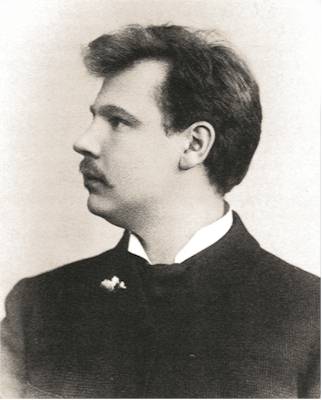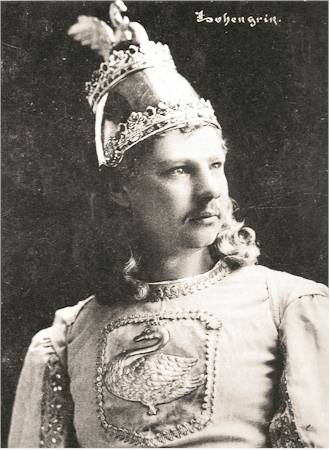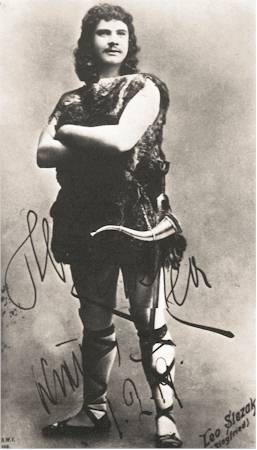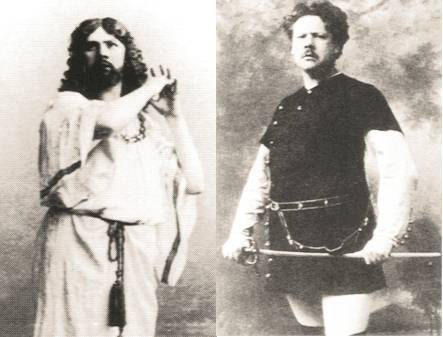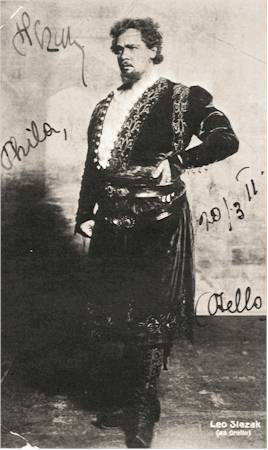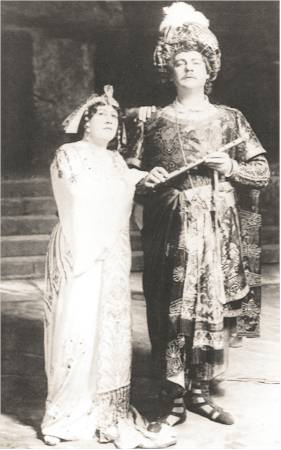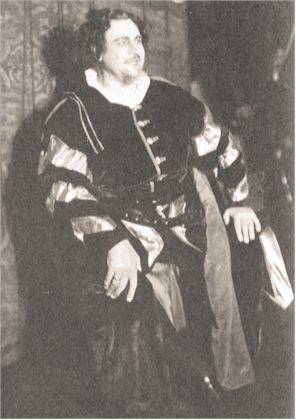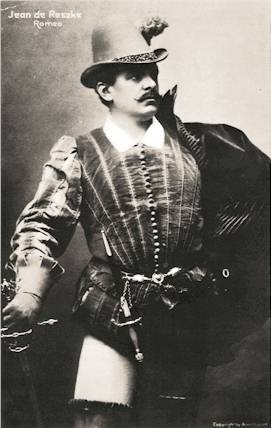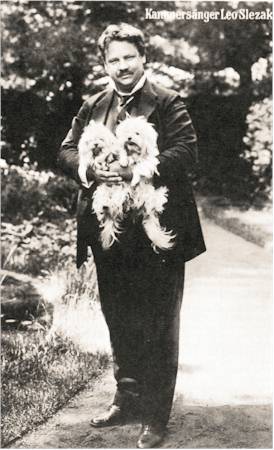Austrian-Czech tenor, 1873 - 1946
Biographical notes: Leo Slezak was born in Schönberg (now Šumperk), Moravia, in 1873. He was the son of a poor miller, who lost his mill. The family settled in Brünn (Brno), where Leo went to school. First he became a gardener, then a locksmith. In his free time he worked at the theatre in Brünn, happy when he was able to start singing as an amateur in the theatre choir. The world famous baritone Adolf Robinson offered him a great future as a singer if he studied hard with him. In 1895 Slezak made his first contact with the Vienna Court Opera House, but he decided to go on studiying with Robinson. It was in 1896 that he made his stage debut as Lohengrin. The success was overwhelming and he appeared in numerous roles at the opera house of Brünn. A guest appearance in Berlin in 1898 resulted in a five-year contract, but Slezak was restricted to sing small roles. He suspended the contract and worked hard to get a larger repertory, consisting now of roles like Jean in Le Prophète, Tannhäuser, Manrico, Adolar Euryanthe, Canio, Lohengrin, Florestan, Stolzing, Turriddu, Erik, Radames, Des Grieux, Tamino, Froh and Siegfried.
As Lohengrin - rare photograph at the beginning of his career In 1900, in his first season in London he sang Lohengrin, Tannhäuser, Froh and the title part of Siegfried. In the same year he married the actress Elisabeth Wertheim. A year later their daughter Margarete Slezak was born, she was to become an acclaimed soprano. Guest appearances in Vienna were tremendously successful and it was in 1901 that Slezak’s long association with the Vienna Court Opera House began. He belonged to a superb ensemble of singers, headed by conductor and composer Gustav Mahler. In 1902 Slezak’s son Walter was born (he became a famous movie actor). Leo Slezak debuted at La Scala, as Tannhäuser opposite Giannina Russ, Adamo Didur and Giuseppe de Luca. When Mahler left Vienna in 1907, Slezak decided to restudy his voice with Jean de Reszke in Paris. Returning to Vienna, he was better than ever before. The Met invited him in 1909, but he never gave up his contract in Vienna. His Met roles included Otello, Radames, Stradella, Lohengrin, Faust, Hermann in The Queen of Spades, Stolzing, Tannhäuser, Manrico and Tamino (opposite Emmy Destinn). He also gave recitals and toured with the company. The American years were a high point in his career. At Vienna he sang Eléazar, Radames, Faust, Lohengrin and Assad in Goldmark’s Die Königin von Saba, Jean in Le Prophète and Raoul in Les Huguenots. His contract ended and a new one was not signed. The opera house was not able to pay his his high salary, and he left the company.
As Siegfried - he recorded “Nothung! Nothung!” only once During the next year he toured the USA, Austria, Germany, and the Netherlands on stage and in concert. Everywhere he was overwhelmingly acclaimed. In 1917 he got a new contract with the Vienna Court Opera, becoming a member until his retirement! During the war he lost his money and he began to sing also in places of lighter entertainment. In 1926 he became an honory member of the Vienna State Opera and at the end of the 1920’s he was heard on the operetta stage too. At the end of his career he was still able to sing great parts like Otello, Tannhäuser etc. It was after a performance of I Pagliacci with Clemens Krauss (1934), that he decided to retire. After 1932 he started a new career as an actor, starring in 43 films with Zarah Leander, Magda Schneider, Hans Moser, Heinz Rühmann among many others. In 1943 he settled at Rottach-Egern (Germany), where his wife died in 1944. Leo Slezak published three lighthearted books of an autobiographical character. After the war he tried to write another book bud died in 1946. The book was completed by his daughter Margarete (“Mein Lebensmärchen”).
As Jean in Meyerbeer’s “Le Prophète” (left) and as Manrico in “Il Trovatore” (right)
As Otello
Emmy Destinn and Leo Slezak in “Die Zauberflöte”, Met 1912
In the title role of Offenbach’s operetta “Barbe-bleue”, Berlin 1929 Comment:
Leo Slezak was one of the most celebrated tenors at the Vienna Court Opera. Like many singers of his time, he was not limited to a particular set of roles. Today we would need at least three
different singers to cover the range of Slezak’s repertoire! Only a few months after his first appearance in Vienna his career as a recording artist began. He
recorded more than 450 sides from 1901 until 1937. His voice can be described as a lyric-dramatic tenor (he sang the heavier parts such as Siegmund and Siegfried only
occansionally), characterized by a remarkable mezza voce and a wonderful head register. His voice was very well suited to the early recording equipment. However, it is not an easy task for
sound-engineers to capture his voice at a correct pitch. According to what we can hear on records Slezak’s voice darkened considerably after his
restudy with Jean de Reszke. Comparing the following two sound files, “Magische Töne” from Goldmark’s today much negleceted but beautiful opera Die Königin von Saba, one can learn that in
the first one from 1905, his voice is much brighter in tone than the later one from 1909. In this aria, we can also admire his mastery of the head register (the first version is sung with a perfect
falsetto high C at the end). Slezak was a superb concert and lieder singer. His Lieder recordings show his fine breathing technique as well as his marvelous use of mezza voce.
Jean de Reszke
(born Jan Mieczislaw in Poland, 1850 - 1925)
The greatest tenor of the later part of the 19th century
with his dogs...
|
|||||||||||||||||||||||||||||||||||||||||||||
